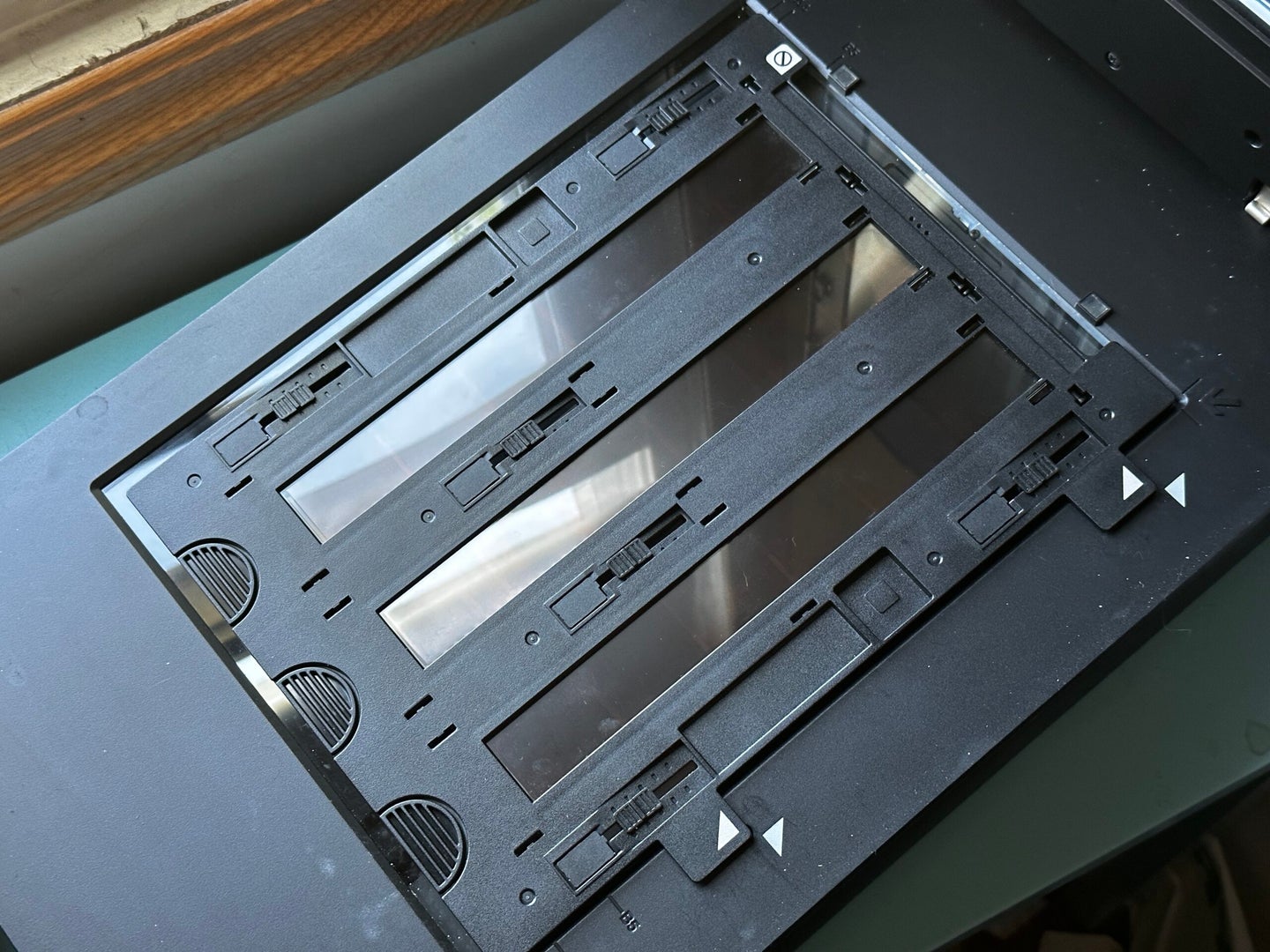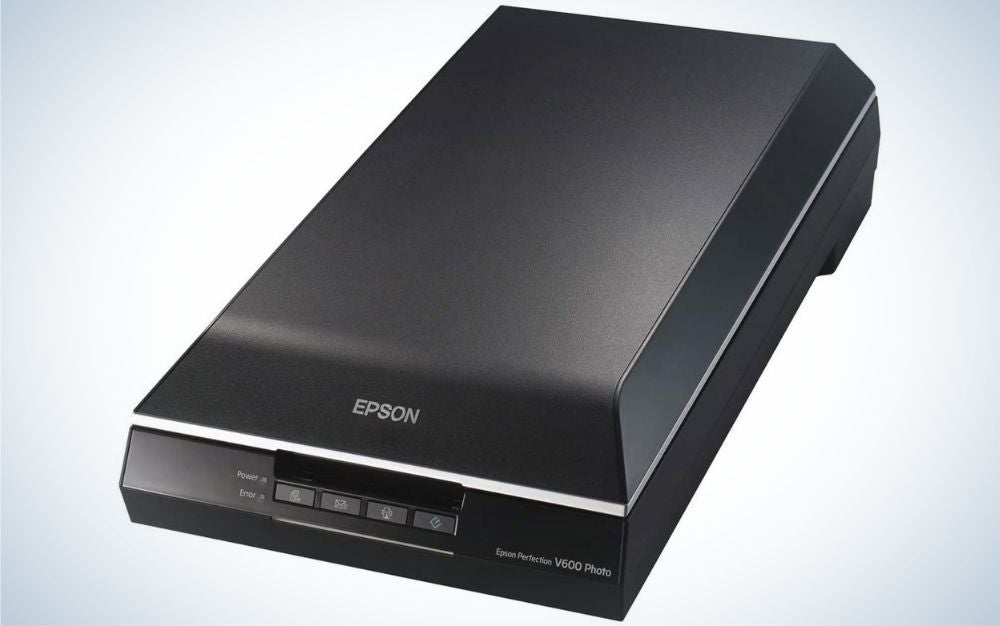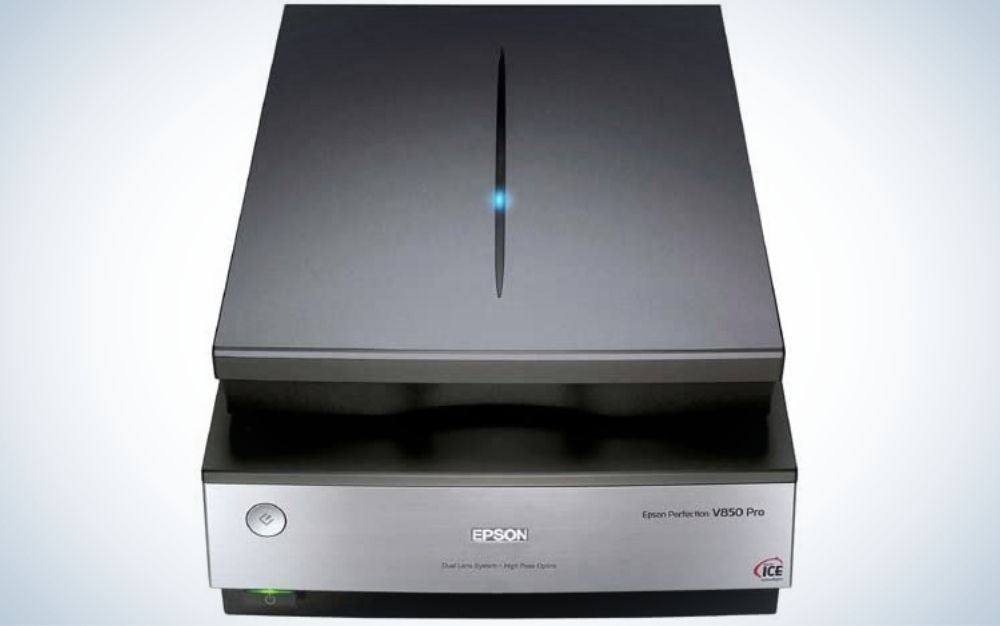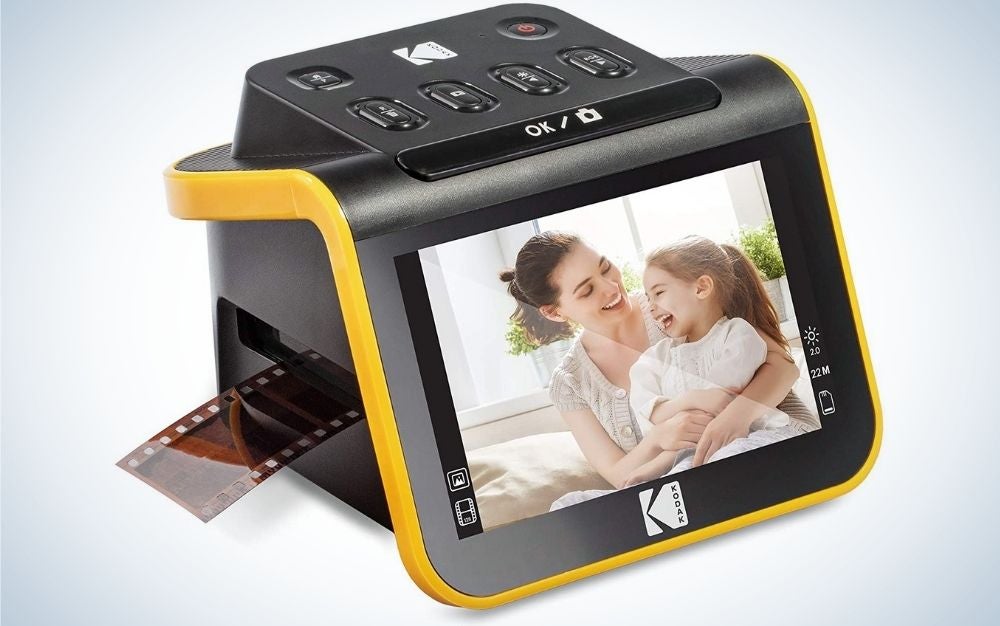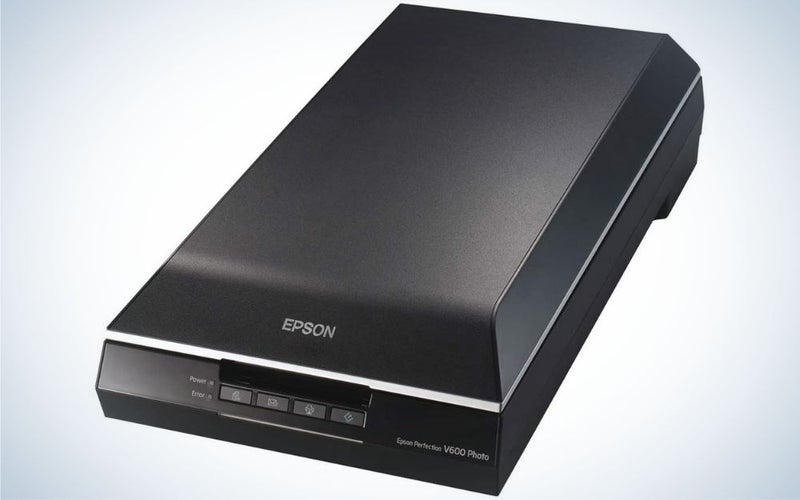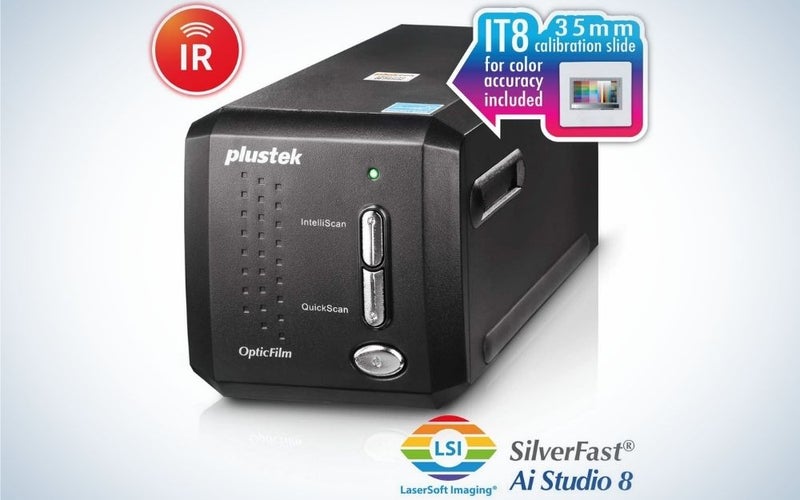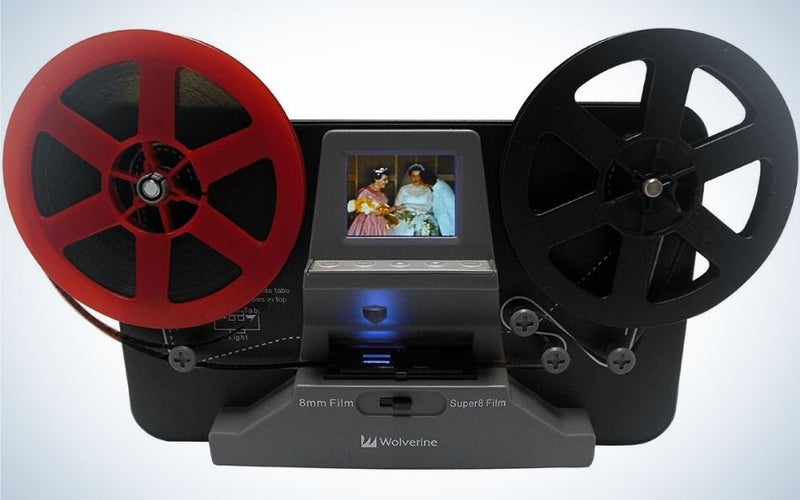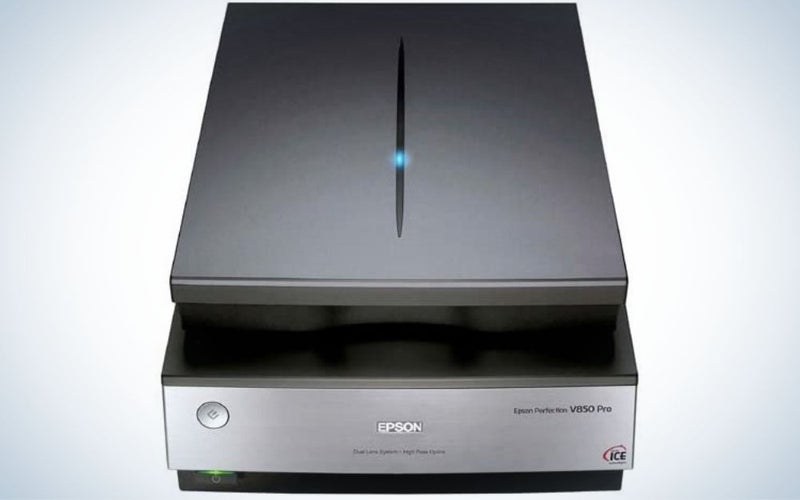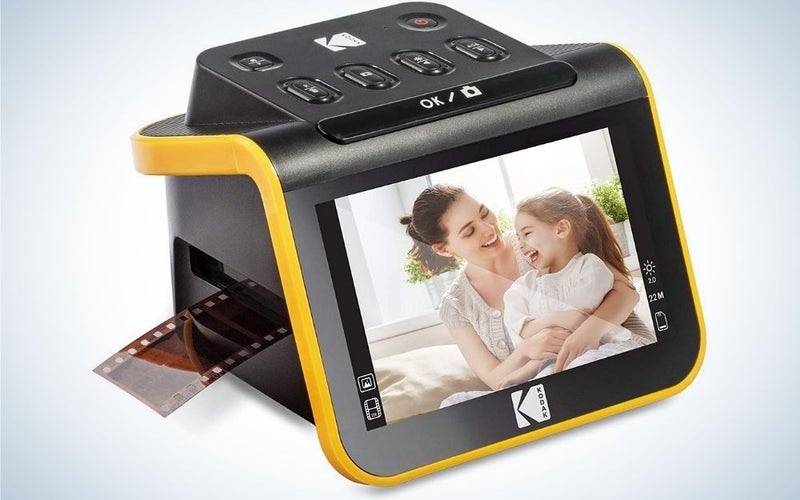We may earn revenue from the products available on this page and participate in affiliate programs. Learn more ›
Film scanners help bring the magic of analog photography into the digital world. There’s a look and texture to film photography and video that their digital counterparts can’t capture. However, you can’t deny the ease of editing and sharing digital photos. Enter the film scanner, which converts film images to digital format. Film scanners aren’t just for photography either. There are also film scanners that convert 8 mm and Super 8 film into easily edited and shared MP4s. The best film scanners preserve the look and feel of the original film and make it easier to edit, share, and replicate your work.
Film scanners come in different sizes, use different technologies, and may only work for certain types of film. Others work with several types of film as well as scan documents and printed photos. Consequently, your chosen film scanner will need to work for the type of film you use as well as offer the quality that works for your purposes. Professionals will need the manual control and versatility of a more expensive film scanner, while hobby photographers don’t need to make the same financial investment. Read on to get the lowdown on the best film scanners, along with tips to help you choose the best film scanner for you.
- Best flatbed scanner: Epson Perfection V600
- Best negative scanner: Plustek OpticFilm 8300i Ai Film Scanner
- Best for digital video: Wolverine 8mm and Super 8 Film Reel Converter Scanner
- Best professional: Epson Perfection V850 Pro Scanner
- Best budget: Kodak Slide N Scan Film and Slide Scanner
How we chose the best film scanners
Since there are different types and sizes of film scanners, we aimed to choose a wide selection that would fit the needs of most people. Beyond that, we looked at features such as maximum resolution, supported formats, usability, durability, and speed. We also picked scanners at a range of price points in order to make film scanning more approachable.
The best film scanners: Reviews & Recommendations
Scanning your film not only allows you to share your results in the digital world but it also gives you a backup in case something damages your negatives. Here are our favorite film scanners for a range of users and applications.
Best flatbed scanner: Epson Perfection V600
Epson
Specs
- Scanner type: Flatbed
- Resolution: Up to 6,400 dpi
- Formats supported: 35mm, mounted slides, 120 up to 6 x 22
Pros
- Relatively affordable
- Versatile since it can also scan prints and documents
- Quicker than some dedicated film scanners
- Included software is decent
- LED light source doesn’t need to warm up, uses less electricity than older models
Cons
- Film holders are a bit flimsy
- Loud
The Epson V600 features 6400dpi optical resolution that’s high enough for film and print scans. It works for 35mm film, 35mm slides, and medium format film and completes a scan in 21 seconds. That’s not the quickest scan speed, but it’s a great balance of speed and scan quality. This Epson also features Digital ICE Technology that removes dust and scratches for cleaner scans.
This is a great option if you’re shooting film semi-regularly, but you’d also like some flexibility. Take out the film holder and insert the opaque pad in order to make this into a useful print and document scanner.
The LED light source doesn’t need to warm up like older versions of these scanners. Plus, the included software makes scanning relatively simple if you don’t want to use something more complex like Silverfast or Vuescan (though, we’re particularly fond of Vuescan).
Best negative scanner: Plustek OpticFilm 8300i Ai Film Scanner
plustek
Specs
- Scanner type: Dedicated film scanner
- Resolution: Up to 7200 dpi
- Formats supported: 35mm strips and mounted slides
Pros
- Very sharp, vibrant scans
- Includes a copy of SilverFast Ai Studio which is expensive on its own
- Easy to line up and insert film
- Relatively automated process
- Built-in infrared channel for dust removal
Cons
- No medium format compatibility
- Pricey
The Plustek OpticFilm 8300i AI includes a 7200dpi optical resolution (although max resolution scans can take up to two minutes). This model is more specific in what it scans, which includes only 35mm film and 35mm mounted slides. However, the Plustek stands out for the included software, SilverFast 9 Ai studio. This software lets you preview, adjust settings, and share and organize files without connecting to additional programs. Most scanners of this type max out at 35mm film, but some more expensive models will accept medium format.
This is a more professional option for people who shoot a lot of 35mm. It comes with Silverfast software, which is very advanced and requires a bit of practice. With some work, though, it provides excellent sharpness, dynamic range, and color.
A built-in infrared channel makes this scanner considerably better at automatically removing dust and scratches than a typical scanner. Plus, it’s easy to insert the film into the surprisingly sturdy holders without having to fuss around like you would with a flat bed.
Best for digital video: Wolverine 8mm and Super 8 Film Reel Converter Scanner
Wolverine
Specs
- Scanner type: Film strip
- Resolution: 720p
- Formats supported: 8 and Super 8
Pros
- Saves movies to removable media
- Easy to set up
- Relatively quick
- Can play back old film movies on a TV via HDMI
Cons
- Expensive if you only have a few films to convert
The Wolverine 8mm and Super 8 Film Reel Converter Scanner fits 8 mm and Super 8 reels up to 5 inches in diameter and converts them into MP4 format. The MP4s are saved onto a removable SD SDHC card (that’s not included with the scanner). The Wolverine can also connect to a TV using an HDMI cord for playback. The scanning and conversion process is fairly slow, but if you have a lot of film to convert, this model is far more affordable than having the scanning done professionally.
Best professional: Epson Perfection V850 Pro Scanner
Epson
Specs
- Scanner type: Flatbed
- Resolution: Up to 6,400 dpi
- Formats supported: 35mm, mounted slides, 120, 4×5
Pros
- Large scanning area makes quick work of multiple frames
- Included film holders include anti-Newton ring glass for better resolution without artifacts
- Can scan up to 4×5 images, including a wet mount option (only in the 850, not the 800)
- Included software is passable
- Dedicated infrared channel for dust removal
Cons
- Loud
- Bulky
The Epson Perfection V850 comes with a high price tag, but that’s because it includes premium features and extras. It includes film holders for 35mm mounted slides, 35mm film, medium format strips, and 4 x 5 sheet film. You can also run the scanner without using one of the holders. This model features a dual-lens system that includes high-resolution and super high-resolution lenses and automatically adjusts them based on the scanning media and resolution selection.
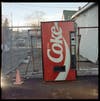
This has been my primary film scanner for several years now, and I’ve learned its quirks. The film holders are decent but require some finagling to get the film to lay perfectly flat. The ANR glass in the holders helps keep them off of the scanner surface itself, which is nice, but curly film can be tricky to get settled.
The 800 and the 850 are both capable of large-format film scanning. I’ve used the 800 to scan 4×5 negatives with solid results. The 850 comes with a fluid-mounting kit that makes large-format scanning much more effective. It also takes a lot more work.
You’ll occasionally run into dust issues that create solid-colored lines across the images, but it’s easily fixed with a quick wipe of the glass. You’ll just have to scan the negatives again, which can be annoying.
Best budget: Kodak Slide N Scan Film and Slide Scanner
KODAK
Specs
- Scanner type: Negative scanner
- Resolution: 22 megapixels
- Formats supported: 35mm, 110, and 126
Pros
- Very easy to use
- Preview screen makes stand-alone scanning simple
- Relatively quick
- Quiet
- Stores images on removable media or sends straight to a computer
Cons
- Image quality is just OK
- Expect to do some tidying of the scans if your negatives aren’t meticulously clean
The Kodak Slide N Scan Film and Slide Scanner includes holders for 50 x 50 hinged slides, 135 film, 126 film, and 110 film. It can also scan 35mm negatives and slides. Scans go quickly, taking only a few seconds, and they’re transferred directly to a laptop or computer via a USB cord. You can make a few adjustments to the negatives, but this model won’t correct most problems, especially film damage that comes from age.
At less than $200, it doesn’t take many rolls of film to justify the price of this device when you compare it to many image-scanning services. It also works with unusual formats (at least for today), like 126 and 110. So, if you have particularly old film hanging around, this is a simple way to digitize.
Don’t expect meticulous scans. The quality is decent but nowhere near what you’d get out of a more advanced film scanner. You’re also on your own for cleaning up the negatives before scanning unless you want to spend a lot of time retouching out dust and other objects once the scan is done.
Still, you’d be hard-pressed to find a simpler, more convenient solution for scanning old photos.
What to consider when shopping for the best film scanners
Shooting film is exciting, and it provides a look that can’t quite be replicated with digital. But you’ll want to digitize those results with a scanner in order to share the images and to keep them safely backed up in case something happens to the negatives.
The best film scanners capture the light, shadows, and colors of the original film with accuracy and clarity. When choosing, you need to be cognizant of the type of film you intend to scan and what you plan to do with the scans. Film scanners come in one of three basic types—flatbed, dedicated film scanners (also known as transparency or slide scanners), and drum scanners.
Drum scanners provide the best scan quality. However, they’re expensive, difficult to find, and the scanning process takes a long time. For that reason, they’re not on our list since, unless you’re looking to start your own professional film scanning business, this type isn’t economical or practical. For reference, they can cost well over $10,000.
Flatbed scanners (often) offer a versatile range of uses.
If you’ve ever seen a standard photo scanner, you’ll recognize a flatbed film scanner. These models feature a clear, glass bed with a lid. You lift the lid, place the film, and start scanning. Most typical flatbed scanners have a single light source that goes under the document. Flatbeds that scan film, however, have another light source in the lid to illuminate the negatives or slides. They work by passing light through the image, which then gets reflected back to the CCD image sensor. The CCD uses red, green, and blue filters like old-school digital cameras.
These models often can work with several different formats like 35mm, slides, or format film. You will have to adjust settings based on the type of film being scanned. However, the biggest perk of a flatbed scanner is that they’re usually multifunctional, scanning developed photos and documents for digital use, too. They are popular and versatile, but some can be difficult to use, requiring setting adjustments with each scan.
Capture deeper darks and lighter lights with a negative scanner
Negative scanners, also called slide scanners, apply the same principles as flatbed scanners but with greater precision and focus. They use a narrow beam of light that passes through the film to better replicate light intensity and color differences. These models also feature a feed that moves frames through the scanner for you. How many frames the scanner holds varies by the make and model.
The downside with this type is that the mechanism that moves the film through the scanner can potentially scratch the film if it’s not cleaned and carefully maintained. They’re also often slow and sometimes rely on finicky software.
Photo and slide negatives aren’t the only film in need of scanning
Gone are the days when you need a projector and video camera to convert your old reels into digital format. Film scanners designed for movie reels can now do it for you. These models convert 8mm and Super 8 film reels into digital videos, which can then be edited or shared.
These machines feature a screen to watch the film in action before and during the recording process. Some models connect to a TV via HDMI for instant playback. Each machine only fits reels of certain sizes, so check to make sure that the reels you have are compatible with the ones you are looking at. While these machines do a great job of transferring visual media, they do not have the capability to record sound. If there’s audio with your movie, you’ll have to add that in using a program or app later on.
The professional needs photography equipment that can keep up with high demand
Professionals and photographers who regularly use film may want to invest in a film scanner with a few extras. Professional-grade scanners typically offer higher resolutions, multiple lenses for greater versatility, and software that expands what you can do while scanning and with the scans once they’re done.
Professional-grade models also include film holders of different sizes to accommodate a wider range of film types.
Save your photos and cash with a budget film scanner that’s gentle on film. What do you get for a film scanner under $75?
Many film scanners require an upfront investment, though they’ll save money in the end if you’ve got a high volume of film to scan. However, hobby photographers may not need many of the fancy extras like dual lenses and multiple film holders.
The biggest difference you’ll notice between these scanners and more expensive models is the scan quality. Budget models may fit several film types, but they typically scan slower and offer lower resolutions with minimal correction options. They’re best for preserving film that won’t come under professional scrutiny.
FAQs
Q: Is it worth buying a film scanner?
Taking your film to a professional scanning or conversion service can get pricey. If drawers of film or reels have taken over your home office, a film scanner will save you a lot of cash. Of course, you’ll have to put in the time to do the scanning, but it’s often worth it to make corrections yourself.
Q: Can you scan film on any scanner
Not all scanners can scan film. Flatbed scanners are the most versatile, but not all of them are designed for film if they don’t have a light source in the lid. Make sure film is specifically listed as a feature before investing in the scanner.
Q: How do I choose a film scanner?
Choose a film scanner based on your budget, film habits, and what you want to do with the scanned images. Film scanners aren’t cheap, so decide on a budget and get the best model you can afford within your budget. Are you an avid photographer or filmmaker? If so, it makes more sense to invest in a professional-grade film scanner. Only invest in an expensive model if it will make it less expensive for you to convert your film and movies over time. Finally, if you’re a casual or hobby photographer, save a few dollars and get an entry-level model. The scans won’t be professional quality, but they’ll certainly preserve your adventures.
Final thoughts on the best film scanners
- Best flatbed scanner: Epson Perfection V600
- Best negative scanner: Plustek OpticFilm 8300i Ai Film Scanner
- Best for digital video: Wolverine 8mm and Super 8 Film Reel Converter Scanner
- Best professional: Epson Perfection V850 Pro Scanner
- Best budget: Kodak Slide N Scan Film and Slide Scanner
The best film scanner can take what’s old and make it new. They can also give you the power to easily edit and share the results of your current film work. Determine a budget and the scan quality that fits your goals. Whether that’s a slide scanner or flatbed will depend on the type of film you use and what you plan to do with your film once it’s in a digital format. But, the right film scanner can become a go-to among your camera equipment, saving money and giving you the ability to share your work with the world.
Why trust us
PopPhoto has a long history of delivering the opinions of some of the sharpest and most prolific camera dorks the world has to offer. Since 1937, we’ve been reviewing cameras, providing wisdom from well-known photographers, and generally just nerding out about all that goes into making great pictures. Our current crop of writers and editors have decades of professional photography and camera writing experience among them. Collectively, we’ve probably shot with just about every camera and lens combo you can imagine—as well as some obscure stuff you may not even know about. Remember the Casio Tryx folding camera? PopPhoto does.
We also get that buying a camera is a big decision, which is why we’re dedicated to helping folks choose the right one (or, in our case “ones”) for their needs. Case in point: Handing over top dollar for an expensive rig may leave you unsatisfied if it doesn’t fit your preferred shooting style. Sure, a $6,000 sports-oriented DSLR can capture landscapes, but do you really need to do it at 30 frames-per-second? No, you don’t.
